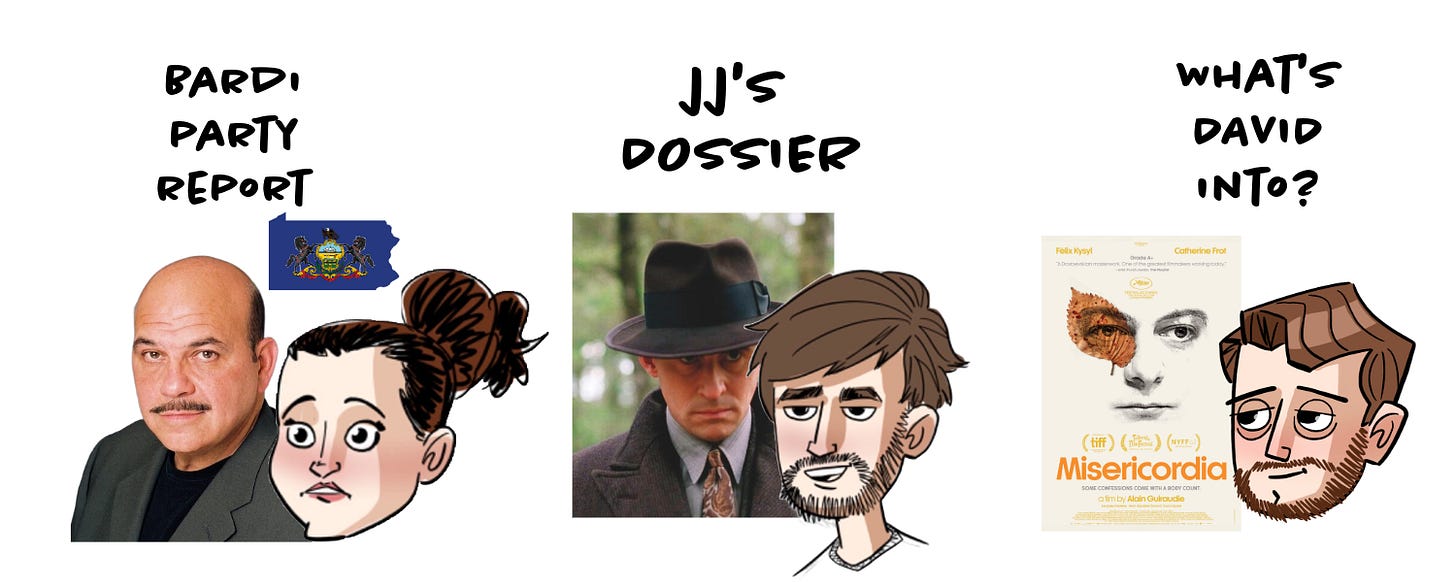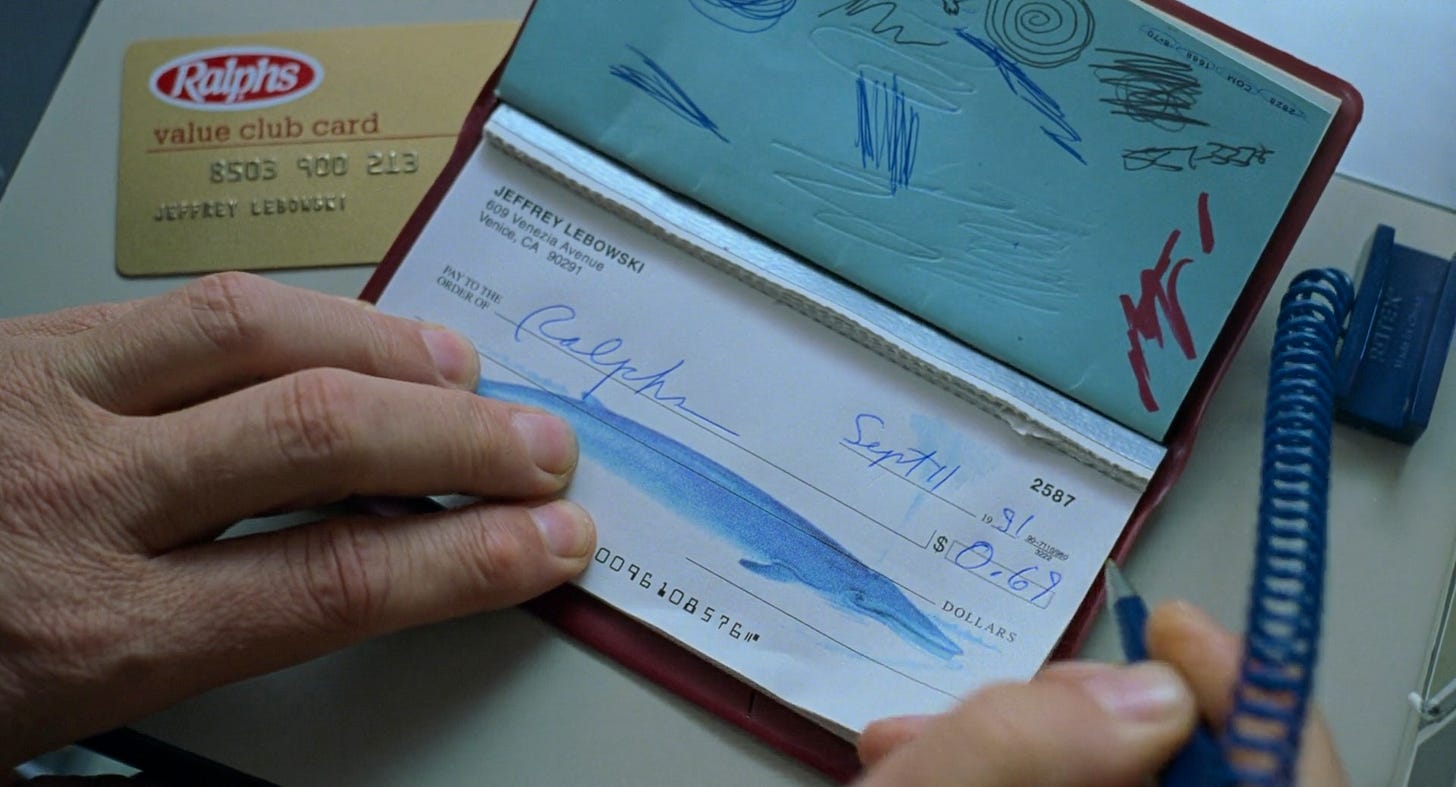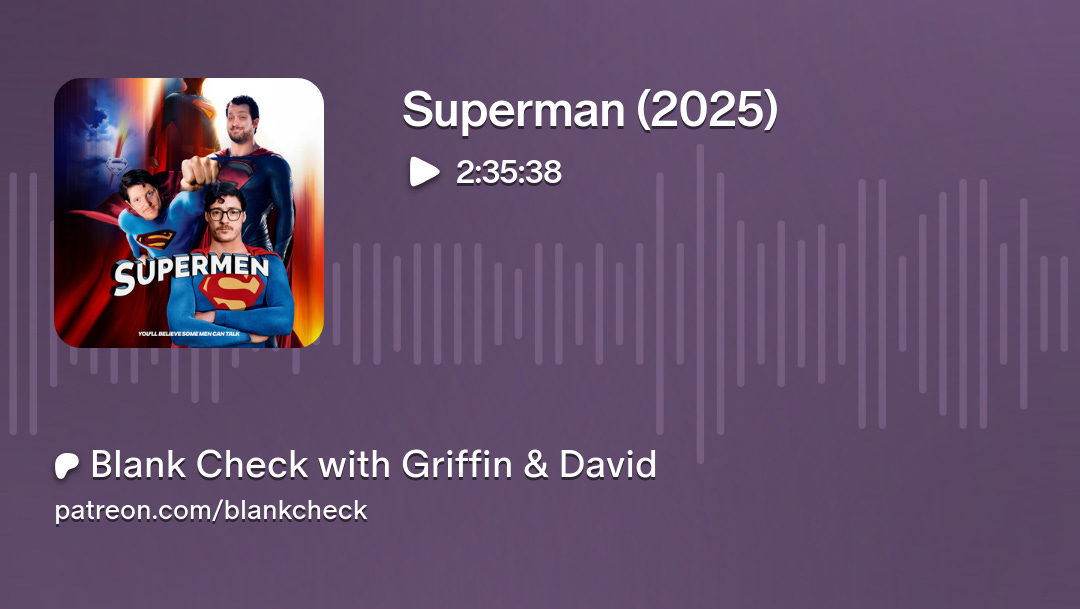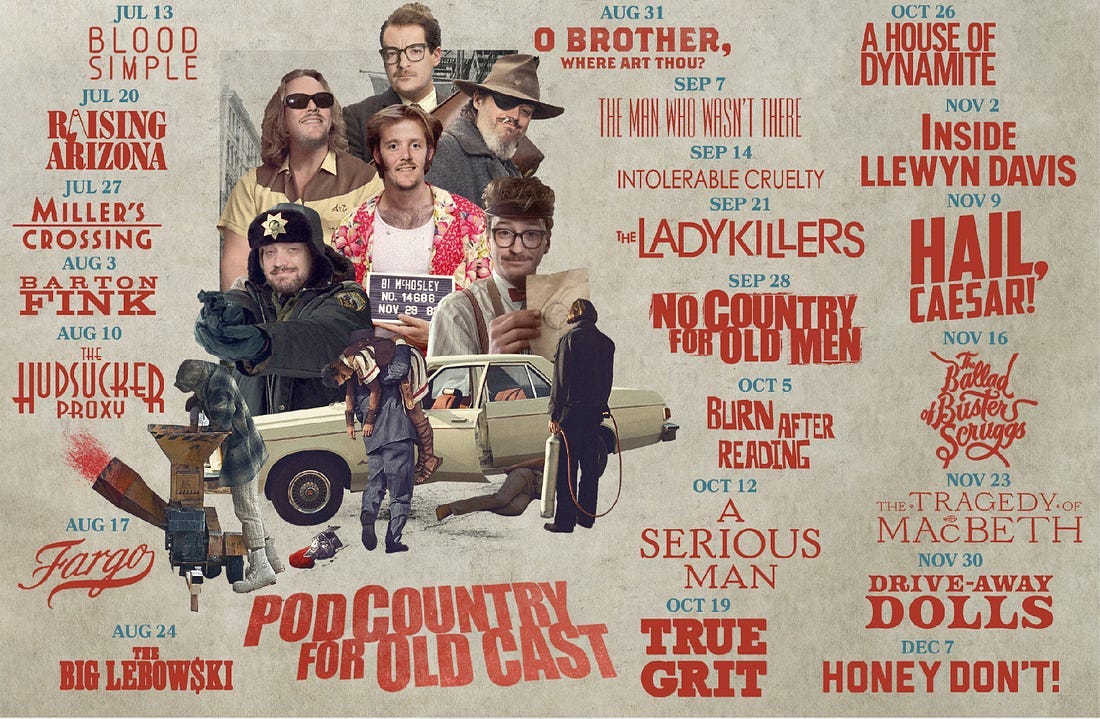Surprise! Blank Check has started a newsletter! Your favorite connoisseurs of context are gonna go on even more tangents, commit to even more bits, and share opinions on even more pieces of entertainment industry news because - hey, why not. Thanks for joining us!
IN THIS WEEK’S EDITION:
THE BARDI PARTY REPORT
Hello Friends. I feel we are due for a check-in on Marie’s Coen Thoughts considering that these first three films were three of my biggest blindspots. Also, as you know, I’ve been traveling and then I got COVID, so I haven’t really been keeping up with the latest theatrical releases. I did finally see Superman (2025), though. Did you know that David Corenswet is from Suburban Philadelphia??? MY SUPERMAN HAS EATEN A WAWA HOAGIE.
Anyway, back to the Coens.
I think my biggest realization from this trio of films was that I’d never actually seen any of the Sonnenfeld collaborations. They feel so different from the Deakins movies - that camera is LOONEY TUNES! I literally yelped out loud when we got an Evil Dead rushing shot in Blood Simple.
It’s been fun to see Coens stock players show up for the first time - Buscemi and Goodman both look so YOUNG. I wish Fran McD continued to cameo in all of their subsequent productions. Give my girl a bad wig and she’ll deliver something special.
I loved all the shades of green in Miller’s Crossing. Felt very Edward Hopper.
My ranking thus far:
Raising Arizona, 2. Blood Simple, 3. Miller’s Crossing.
Raising Arizona just felt so unique to me - a screwball comedy about infertility and morality that looks like a live action cartoon, but managed to make me cry? How do they walk such a tightrope?! I loved how tense the ending of Blood Simple was, and how elegantly it was shot. Miller’s Crossing I admire more than love. I think of these first three films, it’ll be the one to most improve upon rewatch, once I stop trying to keep track of plot. There’s nothing more foolish than a man chasing after his own hat, or a Marie trying to reference a wikipedia plot summary while the film is still playing.
THIS WEEK ON TO THE WHITE SEA
Hey Bookkeepers -
Hope all’s been going great with you. Back at you again with another To the White Sea episode we think you will love. This week we interviewed the G.O.A.T., lifelong Coens Sound Editor, Skip Lievsay! Together we look at scenes of “perfect quiet” where the volume of the audio track drops down to near zero, but what you do hear is a trip to the astral plane, where what Skip calls “zen sound effects” hang out. We discuss Skip’s process of working with the Coens, which is all about patience, perceptiveness, and playful experimentation. He also has a story about working with Terrence Malick that I think is super profound.
Coens Check Book Fun Fact: the check Jeffrey “The Dude” Lebowski writes to the order of Ralph’s is for $0.69 and is dated September 11, 1991. Looking at the inflation calculator I would say this was a good deal for a quart of half and half at that time. Also check out the scribbles on the top cover. God, I love the Coens.
KING RALPH LIVE ON VOD!
Tickets and exclusive merch on sale now!
It’ll be available for viewing through the end of August. Don’t miss out!
LET’S CRACK OPEN THE DOSSIER
Raising Cain Hammett
With their first film—1984’s Blood Simple—Joel and Ethan Coen aimed to embody the hard-boiled storytelling of Mildred Pierce novelist James M. Cain. For their third film—1990’s Miller’s Crossing—the Coens looked to another of their crime writer heroes: Dashiell Hammett, the novelist behind Sam Spade and The Thin Man.
This time, however, their approach to emulation was different: as Ethan told The Washington Post, Blood Simple emerged from a desire “to do a story that worked in a 'Cain way,’” whereas Miller’s Crossing was intentionally “something that's a lot closer to the way Hammett wrote.”1 Or, as Ethan told The Boston Phoenix, more simply, “Miller’s Crossing is pretty much just a shameless rip-off of Dashiell Hammett.”2 While there was not a specific Cain text that shaped the details of Blood Simple’s story, the screenplay for Miller’s Crossing was overtly drawn from two Hammett novels: as the Coens told the great crime writer Megan Abbott in 2022, Miller’s threw “the two main characters” and the love “triangle” of Hammett’s 1931 novel The Glass Key into the nameless city of warring factions from his 1929 novel Red Harvest.3 From the latter, the Coens also made use of one of Hammett’s most famous tropes, per Joel: “[Tom Reagan]’s a character who sort of throws everything up in the air and intentionally creates confusion. This is an old Hammett idea — ‘If I stir things up, I’ll be able to deal with the consequences, whatever they are. Something will emerge that I can exploit.’”4
In the shift from Cain to Hammett, the Coens also altered the way their narratives provided information to their audiences. With Blood Simple, the Coens wanted the film’s viewers to have more information than its characters, according to Joel: “What appealed to us about this story is that the characters don't know what's going on, but the audience does, every step of the way.”5 But with Miller’s Crossing, the Coens relished the enigmatic actions taken by their protagonist: “Miller’s Crossing was kind of definitely for us an exercise in doing a Hammett story. It’s that thing of not being in the character’s head and part of the mystery is, who is the main character? Who is he? Like, who’s Sam Spade? Like what’s the deal? So that was totally the exercise for us was doing Hammett as opposed to [The Big Sleep writer Raymond] Chandler or James M. Cain.”6 And I bet that’s the last we’ll be hearing about Cain, Hammett, or Chandler in the pages of this newsletter…
What’s the rumpus (about all those hats)?
While researching David Lynch last year, I came to realize that the broad perception that he was a difficult interview subject was largely unfounded: the director behind such puzzling films as Mulholland Drive and Inland Empire was often quite open about his films and his process, especially with trusted parties like Chris Rodley or Kristine McKenna—he was just hesitant to publicly unpack the meaning of his work. So far, I’ve found the Coens to be similar—though they’re often a bit more straightforwardly contentious with the press than Lynch … and they also have a habit of lying (as a joke).
While their first two films confounded some critics and viewers, the Coens’ reputation for being a little adversarial with the press really began to take shape with the release of Miller’s Crossing, namely due to their resistance to explaining any potential symbolism or higher meaning behind the film’s poetic usage of hats. In Premiere, Ethan claimed that the hats merely seemed right to include, so they were included: “I mean, the whole hat thing, the fact that it’s all hats, is good, because even if it doesn’t mean anything, it adds a little thread running through the whole thing that’s the same thread. It feels good.”7 Joel told Positif in 1991 that “Everybody asks us questions about that hat, and there isn’t any answer really. It’s not a symbol, it doesn’t have any particular meaning. … It’s an image that came to us, that we liked, and it just implanted itself. It’s a kind of practical guiding thread, but there’s no need to look for deep meanings.” Ethan added, “The hat doesn’t ‘represent’ anything, it’s just a hat blown by the wind.”8 The Coens’ unwillingness to engage with interviewers about the meaning of the hats was not, per Joel, “because there’s any, like, hidden mysteries or anything.” No, it was “just because, you know, it’s all there, you know — it’s all there.”9 Only three films into their careers, Ethan was quickly aware of how these kinds of answers shaped the Coens’ shared public image: “Apparently, nobody wants to be satisfied with the movie, as if they absolutely need explanations beyond the images, the story itself. That always surprises me. But if you don’t comply, journalists get the impression that you’re hiding something from them.”10 As we’ll see next week, the Coens’ refusal to engage with questions about symbolism would hit its apex (mountain) with the release of their 1991 Palme d’Or-winner Barton Fink.
Down in New Orleans
In the search for a location that could reasonably approximate the Prohibition-era architecture of Miller’s Crossing’s anonymous city, a couple of obvious candidates—like Chicago or Albany—were immediately ruled out, according to Joel: “We had to shoot in winter, and we didn’t want snow for the exterior shots, so we had to choose a Southern city.”11 Though the Coens did end up scouting a certain Californian city, Ethan felt that it wasn’t enough of the genuine article: “We looked around San Francisco, but you know what that looks like: period but upscale — faux period.”
The real deal was found, however, in New Orleans, which Ethan deemed “a sort of depressed city; it hasn’t been gentrified. There’s a lot of architecture that hasn’t been touched, storefront windows that haven’t been replaced in the past 60 years.”12 Though the Crescent City is also home to some of America’s most eye-popping iconography, the Coens eschewed it entirely: “We took care not to show the picturesque or tourist aspects of the city. We didn’t want the audience to recognise New Orleans.” In doing so, the story’s city remained unspecified, the “typical ‘corrupted town’ of Hammett novel.”13 I’ll soon know if the Coens were successful: on Tuesday, I am going to Disneyland for the first time, and I’ll report back if I spot any Miller’s Crossing’s locations when I ride Tiana’s Bayou Adventure.
Carter Burwell assembles his squad
One thing I should probably make known is that the composer Carter Burwell has a sick ass personal website full of great anecdotes and detailed information about each of his (many!) great scores. The score for Miller’s Crossing, in my opinion, is one of his very, very best—maybe only short of True Grit. But when Burwell first previewed the Coens’ third feature, the tone of the picture was incredibly different: “When the Coens first showed me the rough cut of Miller's Crossing without any music, it was a chilling, violent experience.” After this screening, Burwell proposed composing a “warm” score, hoping it might add another layer to the film’s story: “I wanted to suggest with the music that his actual motivation was his love for Finney, and I proposed doing this with a sappy Irish melody arranged for orchestra.”14 As Burwell told the author David Morgan, “The music had to fit a visual environment that was rich and maybe a little ostentatious - at least an Irish gangster's idea of ostentation - big and sentimental and lush.”15 Though the Coens initially wanted something a little more “neutral,” the shoot came in slightly under budget, and Burwell was granted access to an orchestra for the first time in his career.
While making the extensive preparations needed to pull off this new feat, Burwell ended up finding many of his most important and/or frequent collaborators: “I was introduced to Sonny Kompanek, an orchestrator, who effectively became my orchestration teacher. … [W]e were introduced to the legendary Emile Charlap, the man who contracted essentially all the orchestral recording dates in New York City. … We were introduced to Mike Farrow, who had recently transitioned from being a commercial pilot to a music recording mixer. We ended up working together for another 30 years. … I was introduced to [the music editor] Todd Kasow, and as with Mike Farrow we continued to work together for decades.”16 The Coens found their troupe—John Turturro, Jon Polito, Steve Buscemi, etc.—just as Burwell was finding his own.
A (likely penultimate) note on Barry Sonnenfeld
To close, I have two fun notes on the film’s cinematography.
First up, as David mentioned on this week’s episode, the Coens’ initial operative word for the style of Miller’s Crossing was “handsome.” More specifically, cinematographer Barry Sonnenfeld claims that the Coens wanted the film to look like Philip Kaufman’s 1988 film The Unbearable Lightness of Being, against which Sonnenfeld bristled. Ultimately, the trio agreed that they should just try to make the film look “nice.”17
For the second note, I turn to a 1994 Vogue article that stated that, while shooting Miller’s Crossing, the Coens referred to the A camera as “Elvis” and the camera’s viewfinder as “Little Elvis”—Elvis’s supposed nickname for his penis. And when the day’s shooting was done, the Coens rejected the traditional “that’s a wrap!” in favor of a more idiosyncratic announcement: “Ladies and gentlemen, Elvis has left the building.”18 And with that, ladies and gentlemen, Elvis (this week’s dossier section) has left the building (this newsletter).
WHAT IS THE TEAM INTO THIS WEEK?
David Sims, Host: “I just watched Misericordia while the twins napped this morning and so can you! What if you were French and gay and you went back home to your small town to cause trouble and stare blankly at people while weird shit happened to you? What if there was a local priest who was weirdly focused on mushroom gathering? As you can tell from this description it’s the laugh riot of the year!! And according to recent Blank Check guest Ari Aster, the best movie of 2025!”
Ben Hosley, Producer: The Radio Garden app is for the sentimental freaks! You can listen to radio signals from around the world. I’m obsessed with it. At any moment you can just transport to another place and hear live radio and pretend you are someone else. I’ve been using it as an alternative to mindlessly scrolling on social media. You browse on the app by moving around a 3D globe that displays all the different live broadcasting stations. Try out the site https://radio.garden and give it a spin!
Marie Bardi, Social Media: “Some Sporcle playlist recommendations for the deepest of loser freaks: 20-to-1 Movie Casts, 20-to-1 Directors, 20-to-1 Actresses, 20-to-1 Actors. These are all really difficult, I haven’t been able to get a perfect score on any of them. I’d like to see you try.”
AJ McKeon, Editor: “I’ll recommend finding a Coke Freestyle machine and getting a a Diet Cherry Vanilla Dr. Pepper.”
JJ Bersch, Researcher: “Some music I’ve enjoyed recently: Avalon Emerson’s Perpetual Emotion Machine EP—I adored & the Charm, but it’s nice to have her back in banger mode; the first three singles from Sudan Archives’ upcoming album The BPM—I especially like when she goes super saiyan on the third verse of ‘MY TYPE’; and Jim Legxacy’s Black British Music mixtape—the drums on ‘new david bowie’ !!!”
Alan Smithee, Pseudonymous Editor: “[“We now return to you regularly scheduled Book Recommendation Summer, already in progress”] “The Anthologist” by Nicholson Baker. I read this book in one day. It’s a very gentle, very charming little story about an academic struggling to write the introduction to a poetry anthology he’s working on. If that doesn’t sound like a rip-roaring good time that you wouldn’t be able to put down, well, I don’t know what to tell you. It is. It’s like half a gentle slice of New England academic life, and half a series of fun and insightful little essays about poetry. I’m not generally a big poetry guy, but I think that every poetry collection I currently own I bought because of this book. I think it’d probably make a great August read. Note: this is the only Nicholson Baker book I’ve ever read. I hear his other work can be extremely horny (he wrote a book called “House of Holes”…). This book is… not that.”
Nate Patterson, Playlist Curator / Ben’s Personal Trainer: “For some of the most unique and interesting post-punk you've heard in a little while, check out the album 45 Pounds by YHWH Nailgun. The percussion is face melting. For some poignant-sounding-but-still-rocking indie, check out The Scholars by Car Seat Headrest, an album just full of little hooks and lovely moments, great for the season. If you just want to take a little focused breather, you can't beat the ambient album Lateral from the living master, Brian Eno. And if you want to fully embrace the birth of summer, to bathe in energy of heat and life, I suggest the compilation Roots Rocking Zimbabwe - The Modern Sound of Harare' Townships 1975-1980. Will crush when played at any outdoor hang or cookout. And the Lift Of The Week is: The Bent Over Row! It's like a plank, a Romanian Deadlift, and a bicep curl all in one! So fun! Ben loves them!”
THIS WEEK ON THE PODCAST
It’s the middle of summer, so you know what that means… Ari Aster joins us to discuss the Coen Brothers’ Jon Polito vehicle, Miller’s Crossing. Get your high hats ready!
And over on Patreon, in the epic conclusion of our Superman series we are discussing the newly released James Gunn feature film Superman (2025).
COMING SOON:
The Washington Post, October 6, 1990.
Boston Phoenix, November 19-26, 1998, in Coen Brothers Interviews, ed. William Rodney Allen.
Premiere, October 1990, in Joel & Ethan Coen: Blood Siblings, ed. Paul A. Woods.
The Washington Post, February 2, 1985.
Premiere, October 1990, in Joel & Ethan Coen: Blood Siblings, ed. Paul A. Woods.
Positif, February, 1991, in Joel & Ethan Coen: Blood Siblings, ed. Paul A. Woods.
Premiere, October 1990, in Joel & Ethan Coen: Blood Siblings, ed. Paul A. Woods.
Positif, February, 1991, in Joel & Ethan Coen: Blood Siblings, ed. Paul A. Woods.
Positif, February, 1991, in Joel & Ethan Coen: Blood Siblings, ed. Paul A. Woods.
Premiere, March 1990, in Joel & Ethan Coen: Blood Siblings, ed. Paul A. Woods.
Positif, February, 1991, in Joel & Ethan Coen: Blood Siblings, ed. Paul A. Woods.
New York Times, July 8, 1990.
Vogue, April 1994, in Coen Brothers Interviews, ed. William Rodney Allen.
















As an absolute Burwell stan, I’m about to lose entire days on his website, THANK YOU
Tried Sporcle. First one is Inglorious Basterds. One of my very favorites: gonna nail it.
Get to 17/20; am forced to click Give Up. Doesn't show me the three I missed. Clicked around more; no luck.
I try it again. Answers are wiped so I start from scratch. After 15, right answers are now wrong. Whuh? Oh, now the movie is Lord of the Rings.
Since I started this comment, the movie switched to Tombstone. Only 7 minutes into 20 minute timer. My 15 Basterds names are still green (correct).
This game is total shit.